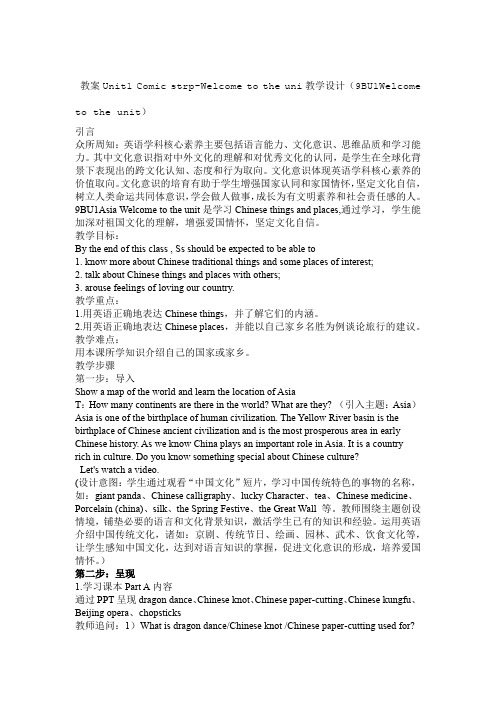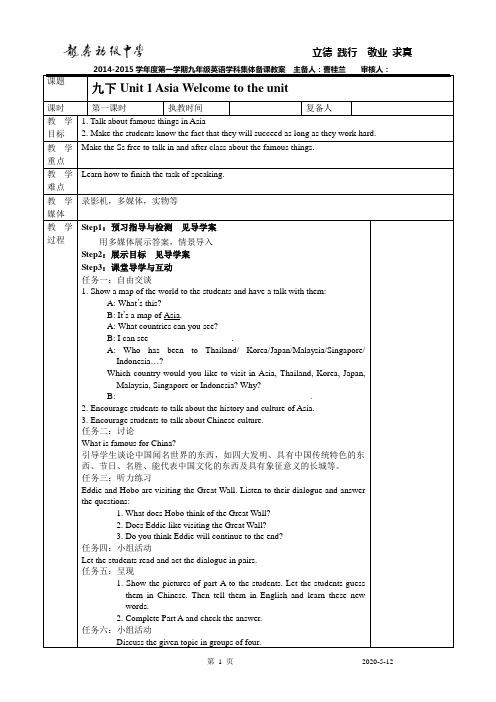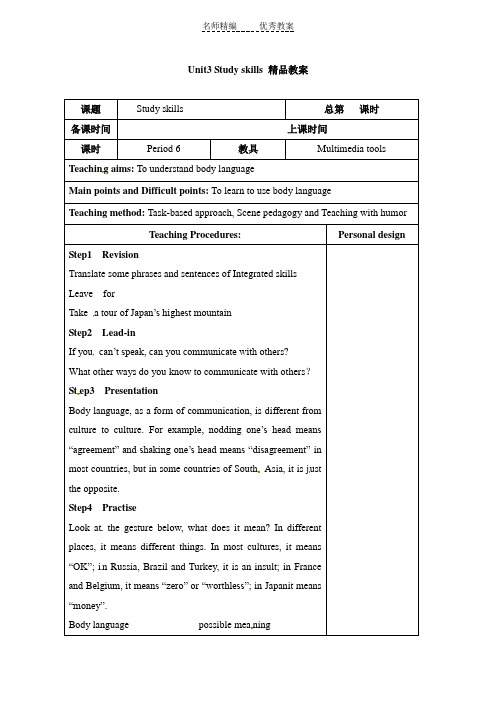江苏新教材牛津英语九下Unit-1-Asia-教案1
- 格式:doc
- 大小:24.00 KB
- 文档页数:2

教案Unit1 Comic strp-Welcome to the uni教学设计(9BU1Welcome to the unit)引言众所周知:英语学科核心素养主要包括语言能力、文化意识、思维品质和学习能力。
其中文化意识指对中外文化的理解和对优秀文化的认同,是学生在全球化背景下表现出的跨文化认知、态度和行为取向。
文化意识体现英语学科核心素养的价值取向。
文化意识的培育有助于学生增强国家认同和家国情怀,坚定文化自信,树立人类命运共同体意识,学会做人做事,成长为有文明素养和社会责任感的人。
9BU1Asia Welcome to the unit是学习Chinese things and places,通过学习,学生能加深对祖国文化的理解,增强爱国情怀,坚定文化自信。
教学目标:By the end of this class , Ss should be expected to be able to1. know more about Chinese traditional things and some places of interest;2. talk about Chinese things and places with others;3. arouse feelings of loving our country.教学重点:1.用英语正确地表达Chinese things,并了解它们的内涵。
2.用英语正确地表达Chinese places,并能以自己家乡名胜为例谈论旅行的建议。
教学难点:用本课所学知识介绍自己的国家或家乡。
教学步骤第一步:导入Show a map of the world and learn the location of AsiaT:How many continents are there in the world? What are they? (引入主题:Asia)Asia is one of the birthplace of human civilization. The Yellow River basin is the birthplace of Chinese ancient civilization and is the most prosperous area in early Chinese history. As we know China plays an important role in Asia. It is a countryrich in culture. Do you know something special about Chinese culture?Let's watch a video.(设计意图:学生通过观看“中国文化”短片,学习中国传统特色的事物的名称,如:giant panda、Chinese calligraphy、lucky Character、tea、Chinese medicine、Porcelain (china)、silk、the Spring Festive、the Great Wall 等。


牛津译林版英语九下Unit 1《Asia》(Revision)教学设计一. 教材分析牛津译林版英语九下Unit 1《Asia》(Revision)主要介绍了亚洲的地理、文化和人民。
本单元通过不同的文章,让学生了解亚洲的自然风光、历史遗迹以及风土人情。
教材内容丰富,贴近学生的生活,能够激发学生对亚洲地区的兴趣,提高他们的学习积极性。
本单元主要包括以下几个部分:1.课文阅读:介绍亚洲的自然地理、历史文化和人民生活。
2.语法讲解:一般现在时和一般过去时的区别和运用。
3.写作训练:以亚洲为题材,写一篇介绍性的短文。
二. 学情分析学生在学习本单元前,已经掌握了基本的英语语法知识,具备一定的阅读和写作能力。
他们对亚洲地区有一定的了解,但可能局限于表面知识,对亚洲的深层次文化和社会现象认识不足。
因此,在教学过程中,教师需要帮助学生挖掘教材背后的文化内涵,拓宽他们的视野。
三. 教学目标1.知识目标:–掌握亚洲的地理、文化和人民的基本知识。
–理解一般现在时和一般过去时的区别和运用。
2.技能目标:–提高学生的阅读理解能力,能够读懂关于亚洲的文章。
–提高学生的写作能力,能够运用所学知识撰写一篇介绍性的短文。
3.情感目标:–培养学生对亚洲地区的兴趣,增强他们的民族自豪感。
–培养学生热爱和平、尊重多元文化的态度。
四. 教学重难点•亚洲的地理、文化和人民的基本知识。
•一般现在时和一般过去时的运用。
•理解亚洲文化背后的深层次含义。
•运用所学知识撰写一篇介绍性的短文。
五. 教学方法1.任务型教学法:通过完成各种任务,让学生在实践中掌握知识。
2.情境教学法:创设真实的情境,让学生在特定的环境中感受和理解知识。
3.合作学习法:鼓励学生相互合作,共同探讨问题,培养团队精神。
六. 教学准备1.教材:牛津译林版英语九下Unit 1《Asia》(Revision)。
2.多媒体设备:电脑、投影仪、音响等。
3.教学素材:相关图片、视频、音频等。

Asia(一)重难点精讲It’s tiring to climb the steps and my feet hurt.tiring adj. (事、物)令人疲劳的,使人厌倦的tired adj. (人)感到疲劳be ________ of 对……感到厌烦It’s _________ for me to walk for 30 minutes.It was a ________day and she felt very _______.类似的形容词有:amazing/amazedexciting/excitedboring/boredinteresting/interested题一:翻译:我讨厌天天待在家里做作业。
step n. 台阶,步骤请小心台阶!Being honest is the first ______if you want to make friends with others.v. 踩I’m sorry to _____ on your foot.There’s still a long way to go.句中to go 是动词不定式做定语。
1. He is always the first person ___________ (e) and the last one _______ (leave).2. There are many interesting books _________ (choose) from, but I don’t know which to borrow.3. There is nothing ______________ (worry) about.题二:翻译:1.一个会见朋友的好地方。
2.我想找一个能互相聊天的人。
go on to do sth.一事做完,接着做另一件事go on doing sth.事情暂停后继续做;一直做某事题三:1)After a short break ,he went on _________(read) the rest of the text.2)After reading the novel, he went on _________(write) an article.used to do sth. 过去常做某事,现在不了be used to (doing) sth. 习惯于某事或习惯于做某事get/bee used to (doing) sth. 变得习惯于某事或习惯于做某事,往往含有“克服困难去适应”之意。

Unit 1 AsiaGrammarI. Teaching aims and learning objectivesBy the end of the lesson, students should be able to:1. use “it” as a personal pronoun;2. use “it” as an impersonal pronoun;2. use “it” to replace the real subject or object.II. Teaching contents1. New words and phrases: quarter, either, level, service, take up2. New structures: It is very tiring to climb the steps.Many people find it pleasant to travel around.It is said that the air is not clean here, but I do not think thepollution is as serious as I imagined.III. Focus of the lesson and predicted area of difficultyTell the different uses of “it”.IV. Teaching proceduresA Using it as a pronounStep 1 Lead-inBrainstormingT: What will you think of when you see the word “it”?【设计意图:通过头脑风暴活动,激发学生的兴趣,引出本课主题。
】Step 2 Presentation1. Use it for animals and lifeless thingsT: Now, let’s play a guessing game. It is a tourist attraction. It lies in the northern part of China. It is a wall which was built to defend the enemy. What is it?S: It is the Great Wall.T: It is a kind of animal. It is very lovely. It wears big black glasses on its face. What is it?S: It is a panda.T: It is a type of transportation. It was invented by an Englishman. It has two wheels and iswidely used in China. What is it?S: It is a bike.T: It is a common thing. It looks like a mushroom. It is used on rainy days. What is it?S: It is an umbrella.T: So, What does “it” refer to?S: We use it for animals and lifeless things.【设计意图:利用学生喜欢的猜谜游戏,激发他们的学习兴趣,在不知不觉中过渡至语法学习,将it指代动物或者无生命的事物的用法自然呈现。

新牛津九年级英语Unit1集体备课教案Tian’anmen Square in the middle of Beijingthe Summer Palace in the north of Beijingthe Great Wall in the north-west of Beijing Read it again and do some true or false questions1〕Beijing is in southern China.2〕Tian’anmen Square is close to the Forbidden City.3〕The Great Wall is built around theForbidden City.4) The Reed Flute Cave is in eastern Guilin5) You can find man-made lakes inside the Reed Flute Cave.6) We can take a boat trip along Li RiverRead the two parts carefully to get some details.1) Match the name with the correct information.2) Ask some questions and get the students to answer.3) Fill in blanks according to the passage.Step 4 ConsolidationDo some exercises on the exercise book.2. Post-teachingDemands(要求):1)Group one asks questions about Beijing and group two answers them.2)Group two asks questions about Guilin and group one answers them.. Rules:1) Time :only one minute.2) Ask and answer as quickly as possible .3)one question, one point; one answer, one point.4) The more, the better.Step5 Homework1.Think overhow to introduce a city2.Have a tryintroduce our hometown to all教后记:总课题9BUnit 1 Asia总课时8 第3课时课题Reading II 课型新授教学目标To revise vocabulary and expressions to describe Beijin and Guilin, at the same time, learn more new words and phrases.教学重难点 1.To revise vocabulary and expressions to describe Beijin and2)What language do people there use 3)What’s the population of the country? 4)What crops are grown in the country? 5)What attractions is the most famous? Step 3 Writing and analyzeAccomplish partB, dealing with some language points. Analyze the structure of the passage IndiaStep 4 WritingGet the Ss to write an article to introduce a country with the help of the useful words and expressions:…is a great country/wonderful place to visit It lies in It is next toIts capital city is… People in ….speak …There are over …people there It’s famous for……is well known and worth a visit Step 5correcting &modifying Get the Ss to correct it in group Modify the article and finish it教后记:总课题 9B Unit 1 Asia 总课时 8第8课时 课 题Revision课 型新授教学目标To review key grammar and vocabulary itemsTo give students the chance to practise the grammar and vocabulary itemsTo allow students to check their progress and ask any questions they may still have教学重难点To review key grammar and vocabulary itemsTo check their progress and tr y to ask questions they may have集 体 备 课二次备课Step 1 Warming-upTian’anmen Square go onIntroductionLanguage,population&crops Customs Attractions。
Unit 1 AsiaTaskI. Teaching aims and learning objectivesBy the end of the lesson, students should be able to:1. get some information about India;2. know how to write about a country;3. write an introduction to an Asian country.II. Teaching contents1. New words and phrases: Hindi, billion, population, iron, IT, technology, custom, fair, sari,Indian, as a second language2. New structures: India has the second largest population in the world.You may have seen them in Indian films.III. Focus of the lesson and predicted area of difficultyHow to write about an Asian country.IV. Teaching proceduresStep 1 Warm upHave a guessing gameT: What a wonderful world! And what a wonderful Asia! There are 48 countries in Asia. Nowlet’s play a guessing game. Please watch carefully and tell what country I am sowing you.S: …T: So this is our country, China. It has the largest population in the world.By the way, how many people are there in China?S: …T: Over 1.3 billion. As Chinese, we should be proud of our country. Please go on.S: …T: Oh, wonderful! Singapore is a city state. How about this one?S: …T: Yes, it’s Thailand. And this is …?S: …T: You are so clever. It’s India, Millie’s favourite Asian country.【设计意图:课前热身,调动学生头脑中已储存的与单元话题相关的知识,激发学生轻松愉快地参与课堂活动;由猜谜活动导入新课,且处理了生词population和billion。
牛津译林版英语九下Unit 1《Asia》(Comic strip and Welcome to the unit)教学设计一. 教材分析牛津译林版英语九下Unit 1《Asia》的主题是亚洲,本课将介绍亚洲的地理、文化和人物。
教材包括漫画、词汇、对话、阅读材料和作业等,内容丰富,贴近学生生活。
通过本课的学习,学生能够了解亚洲的概况,提高英语语言能力,培养跨文化交际意识。
二. 学情分析九年级学生已具备一定的英语基础,对亚洲有一定的了解。
但部分学生英语听说能力较弱,对本课内容可能存在一定的困难。
因此,在教学过程中,教师需关注学生的个体差异,调动学生的积极性,激发他们的学习兴趣。
三. 教学目标1.知识目标:学生能够掌握亚洲的地理、文化和人物等相关词汇;了解亚洲的基本情况;2.能力目标:学生能够运用所学词汇和句型介绍亚洲的相关知识;提高英语听说读写能力;3.情感目标:培养学生跨文化交际意识,增强对亚洲文化的认识和尊重。
四. 教学重难点1.重点:亚洲的地理、文化和人物等相关词汇;2.难点:运用所学词汇和句型介绍亚洲的相关知识。
五. 教学方法1.情境教学法:通过设定情境,让学生在实际语境中学习英语;2.交际法:鼓励学生进行小组合作,培养他们的交际能力;3.任务型教学法:通过完成任务,让学生在实践中掌握所学知识。
六. 教学准备2.多媒体教学设备;3.图片、地图等教学素材;4.录音机、耳机等音响设备。
七. 教学过程1.导入(5分钟)利用图片、地图等教学素材,引导学生谈论亚洲的地理、文化和人物。
激发学生的学习兴趣,为接下来的教学活动做好铺垫。
2.呈现(10分钟)呈现漫画,让学生观察并回答以下问题:1.What are they talking about?2.Can you guess what they are going to do?3.What do you know about Asia?通过漫画引导学生进入学习情境,激发他们的学习兴趣。
牛津译林版英语九下Unit 1《Asia》(Task)教学设计一. 教材分析牛津译林版英语九下Unit 1《Asia》主要介绍了亚洲的自然地理、人文地理以及亚洲各国的主要城市。
本单元的话题贴近学生的生活实际,有利于激发学生的学习兴趣,提高他们的跨文化交际能力。
本节课的Task部分主要让学生运用所学知识介绍自己喜欢的城市,培养学生的写作能力和合作能力。
二. 学情分析学生在学习本单元前,已经掌握了有关地理、气候、城市等基本词汇和句型。
此外,他们对亚洲的一些国家和地区有一定的了解。
然而,学生在写作和口语表达方面还存在一定的困难,如语言能力、词汇搭配等。
因此,在教学过程中,教师需要关注学生的个体差异,充分调动学生的积极性和主动性。
三. 教学目标1.知识目标:学生能够掌握有关城市介绍的词汇和句型,如“The city isfamous for…”,“One of the most famous landmarks is…”等。
2.能力目标:学生能够运用所学知识介绍自己喜欢的城市,提高写作和口语表达能力。
3.情感目标:通过介绍自己喜欢的城市,培养学生对家乡和祖国的热爱之情。
四. 教学重难点1.重点:学生能够掌握有关城市介绍的词汇和句型。
2.难点:学生能够运用所学知识灵活介绍自己喜欢的城市,并在写作和口语表达中运用恰当的词汇和句型。
五. 教学方法1.任务型教学法:通过完成具体任务,让学生在实践中学习和运用语言。
2.合作学习法:学生分组进行讨论和写作,培养学生的团队合作能力和沟通能力。
3.情境教学法:创设真实的情境,让学生在实际语境中学习和运用语言。
六. 教学准备1.教师准备:提前准备相关城市的图片、视频等教学资源,以便在课堂上进行展示和讲解。
2.学生准备:学生提前了解自己喜欢的城市,准备相关素材。
七. 教学过程1.导入(5分钟)教师通过展示亚洲地图,引导学生回顾亚洲的国家和城市,为新课的学习营造轻松的氛围。
2.呈现(10分钟)教师展示自己喜欢的城市图片,并简要介绍该城市的特点,如“The city is famous for its beautiful scenery.”等。